Dental anxiety is a common problem affecting children and adolescents. Childhood dental anxiety is stressful for both the child and their family. It is also related to poor oral health outcomes and an increased dependence on costly specialized dental care [1,2]. In clinical practice only few children respond positively and cooperate for dental treatment, while most of them find it intolerable, some may exhibit phobia to dental procedures [3].
Anxiety is an important stumbling block faced by pediatric dentists in routine practice. It is a special type of fear, felt in anticipation of a frightening stimulus [4]. Rachman’s three – pathway theory states that children can develop anxiety either directly by conditioning or through indirect learning (by modelling or from information) [5,6]. A child’s behavior and cooperation to treatment is greatly influenced by the dental environment. Changing the outlook of the parents and the society would encourage paediatric dentists to build a “child-friendly” environment for treating children, particularly those who are anxious and uncooperative [7]. Environmental factors like colours, that impart a positive feeling in the child’s mind help in reducing dental anxiety [3].
Colour plays an imperative role in a child’s life. In 1939 Goldstein claimed that specific colours elicit specific emotional responses. It can be a stress relieving factor to all [8]. Colour can be perceived biologically, emotionally and thus could impart psychological responses [7]. It has been observed and studied by many clinicians that children’s use of colour in art reflects their emotional status, wherein coordination between light, eyes and brain results in normal response to colour [8,9].
Materials and Methods
A cross-sectional study was conducted among randomly selected 382 children aged 6-12 years in schools of Puducherry, India. The study protocol was approved by the Institutional Ethical Committee, Internal Review Board, Indira Gandhi Institute of Dental Sciences (IGIDSIEC2015NDP02PGAKPPD). In the same institute the study was conducted over a period of 6 months (from May 2015 to October 2015). Written consent and assent were obtained from the parents and all participating children respectively. Sample size was calculated based on the literature [3] and by using the formula, n = Z2 α/2 P (1-P)/d2
(n= sample size, p=0.533 (proportion children with anxiety, d= 0.05, α = 0.05).
A specially prepared proforma was used to document the personal information, modified dental anxiety scale [Table/Fig-1] and the face drawings (emoticons) representing two emotions: Happiness (positive emotion) and sadness (negative emotion) [Table/Fig-2].
Proforma with Modified Dental Anxiety Scale.
| Name of the student :Age / Sex/ Class :Place :Have you ever been to a dentist before, if yes what treatment have youundergone? |
|---|
| Can you tell us how anxious you get, if at all, with your dental Visit ? |
|---|
| 1. If you went to your Dentist for TREATMENT TOMORROW, how would you feel? |
| NotAnxious | SlightlyAnxious | FairlyAnxious | VeryAnxious | ExtremelyAnxious |
| 1 | 2 | 3 | 4 | 5 |
| ––––––––––––––––––––––––––––––––––––––––––––––––––––––––––→ |
| 2. If you were sitting in the WAITING ROOM (waiting for treatment), how would you feel? |
| NotAnxious | SlightlyAnxious | FairlyAnxious | VeryAnxious | ExtremelyAnxious |
| 1 | 2 | 3 | 4 | 5 |
| ––––––––––––––––––––––––––––––––––––––––––––––––––––––––––→ |
| 3. If you were about to have a TOOTH DRILLED, how would you feel? |
| NotAnxious | SlightlyAnxious | FairlyAnxious | VeryAnxious | ExtremelyAnxious |
| 1 | 2 | 3 | 4 | 5 |
| ––––––––––––––––––––––––––––––––––––––––––––––––––––––––––→ |
| 4. If you were about to have your TEETH SCALED AND POLISHED, how would you feel? |
| NotAnxious | SlightlyAnxious | FairlyAnxious | VeryAnxious | ExtremelyAnxious |
| 1 | 2 | 3 | 4 | 5 |
| ––––––––––––––––––––––––––––––––––––––––––––––––––––––––––→ |
| 5. If you were about to have a LOCAL ANAESTHETIC INJECTION in your gum, above an upper back tooth, how would you feel? |
| NotAnxious | SlightlyAnxious | FairlyAnxious | VeryAnxious | ExtremelyAnxious |
| 1 | 2 | 3 | 4 | 5 |
| ––––––––––––––––––––––––––––––––––––––––––––––––––––––––––→ |
The face drawings (emoticons) representing two different emotions: happiness (positive emotion) and sadness (negative emotion).
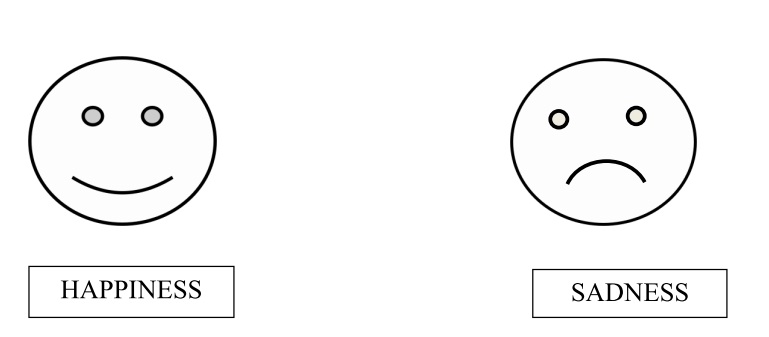
Modified dental anxiety scale was used to record the anxiety level of each participant. Each question (a total of five) is scored from one (not anxious) to five (extremely anxious) such that the total score ranged from 5 to 25. A score of 15 or more was considered anxious. All children were provided with eight crayon pencils (blue, green, yellow, red, pink, orange, achromatic colours such as black and white) and they were asked the following, “Which crayon would you choose to colour the happy face?” They were told to colour the emoticon with their most preferred colour for the positive emotion. Then the drawing representing sadness was shown and asked, “Which crayon would you prefer to colour the sad face?” and they were asked to shade the cartoon drawing with their preferred colour. Readings were recorded by a single examiner. Values were tabulated and statistically analyzed to evaluate the association between the variables using Z test, Chi-square goodness-of-fit and odds ratio. A p value of ≤ 0.05 was considered statistically significant.
Results
Out of 382 children, 250 were boys and 132 were girls. Children in the age group of 6-9 years were considered as younger children (n=257) and 10-12 years were grouped as older children (n=125). All the children were categorized into anxious and non-anxious based on the modified dental anxiety scale; the mean was taken as 15. Values < 15 were considered non anxious (n=88) and those ≥ 15 were considered anxious (n=294). A total of 223 (86.8%) children of the younger age group were graded as anxious, while 34 (13.2%) children were found to be non anxious. Seventy one children (56.8%) of the older age group were anxious, while 54 children (43.2%) were non anxious. There were no drop outs in this study. Compared to older children, younger children showed more anxiety and there was a significant difference (p<0.05) as shown in [Table/Fig-3].
Distribution of children based on age and anxiety.
(Chi-square test).
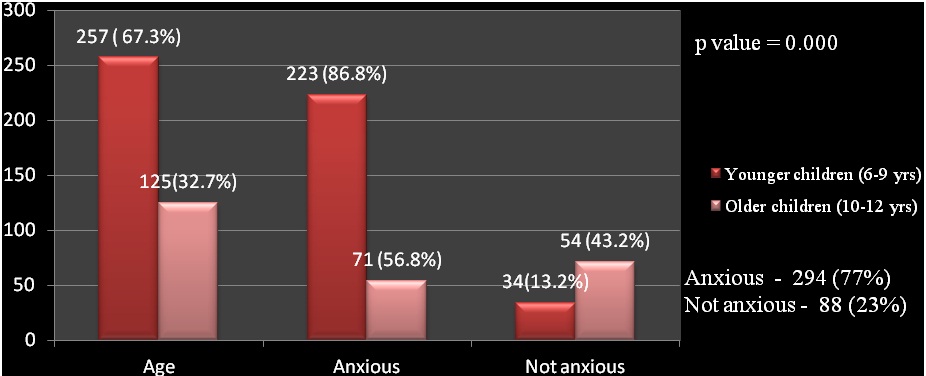
Odds ratio was calculated and it was found that the chance of getting anxiety among younger children (6-9 years) was 4.99 times more likely as compared to older children (10-12) and it was statistically significant (95% CI= 2.92 – 8.54).
For positive emotion, 31.2% (119) of children preferred blue followed by pink 29.3% (112), yellow 17% (65), green 13.1% (50), orange 7.6% (29), red 1.3% (5), and white 0.5% (2) respectively. For negative emotion, 52.1% (199) children preferred black followed by red 46.9% (179), followed by pink, blue, green and orange 0.3% (1) each. The difference between observed and expected frequency of colour preference for positive and negative emotions were found statistically significant (p<0.05). It may be concluded that colour preference varies according to the emotion of the child [Table/Fig-4].
Colour preference to positive and negative emotions.
(Chi-square goodness of fit test).
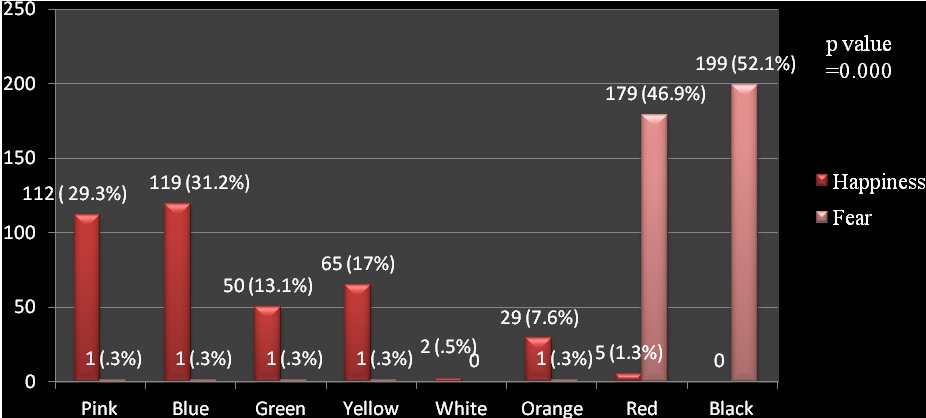
Colour preferences to positive and negative emotions were compared based on gender. Out of 250 boys, 44.8% (112) preferred blue to shade the happy face followed by yellow 17.6% (44), green 16.4% (41), pink 11.2% (28), orange 8.8% (22) and red 1.2% (3) respectively. Among 132 girls, 63.6% (84) preferred pink to shade the positive emoticon followed by yellow 15.9% (21), green 6.8% (9), blue 5.3% (7), orange 5.3% (7), white 1.5% (2) and red 1.5% (2) respectively. Chi-square goodness of fit test was performed to assess the difference between male and female children in preferring different colors. The results revealed that there was statistically significant difference between male and female in preferring blue (p=0.046), yellow (0.004), green (0.001), pink (0.001), orange (0.005) when they are in positive emotion [Table/Fig-5].
Colour preference of children to positive emotion based on gender.
| Colour | Boys | Girls | Total | Z value | p-value |
|---|
| Blue | 112 (94.1%)(44.8%) | 7 (5.9%)(5.3%) | 119 (100%) | 4 | 0.046* |
| Pink | 28 (25%)(11.2%) | 84 (75%)(63.6%) | 112 (100%) | 28 | 0.001* |
| Yellow | 44 (67.7%)(17.6%) | 21 (32.3%)(15.9%) | 65 (100%) | 8.14 | 0.004* |
| Green | 41 (82%)(16.4%) | 9 (18%)(6.8%) | 50 (100%) | 20.4 | 0.001* |
| Orange | 22 (81.5%)(8.8%) | 7 (18.5%)(5.3%) | 29 (100%) | 7.76 | 0.005* |
| Red | 3 (60%)(1.2%) | 2 (40%)(1.5%) | 5 (100%) | 2 | 0.655 |
| White | 0 (0.0) | 2 (100%)(1.5%) | 2 (100%) | - | - |
| Total | 250(100%) | 132(100%) | | | |
* p ≤ 0.05 was considered statistically significant
Chi-square goodness of fit test was used
When color preferences to negative emotions were compared based on gender, it was found that an equal proportion of boys (46.8%) and girls (46.9%) had preferred red. Black was preferred by 52.8% (132) of boys and 50.8% (67) of girls. When the children were in negative emotion, preference of both red (p=0.976) and black (p= 0.704) by male and female children were statistically not significant [Table/Fig-6].
Colour preference to negative emotion based on gender.
| Colour | Boys | Girls | Total | Z value | p-value |
|---|
| Red | 117 (46.8%) | 62 (46.9%) | 179 (100%) | 0.03 | 0.976 |
| Black | 132 (52.8%) | 67 (50.8%) | 199 (100%) | 0.38 | 0.704 |
| Others | 1 (0.4%) | 3 (2.3%) | 4 (100%) | | |
Z – test was used
Colour preferences for both positive and negative emotions were compared with anxiety level and age group. In younger age group, anxious children preferred pink 30.9% (69) followed by blue 25.1% (56) whereas non anxious younger children preferred blue 35.3% (12) followed by pink 23.5% (8). In older age group anxious children preferred blue 29.6% (21) followed by 22.5% pink (16). Among non anxious older children blue was preferred by 55.6% (30) followed by 35.2% (19) pink. Both anxious and non anxious children of all age groups preferred black and red for negative emotion [Table/Fig-7,8].
Color preference for positive emotion based on age and anxiety level.
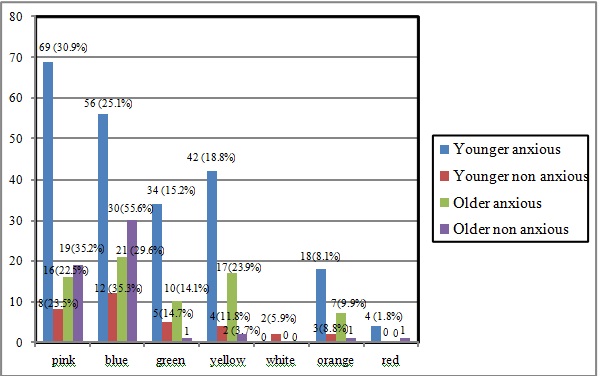
Color preference for negative emotion based on age and anxiety level.
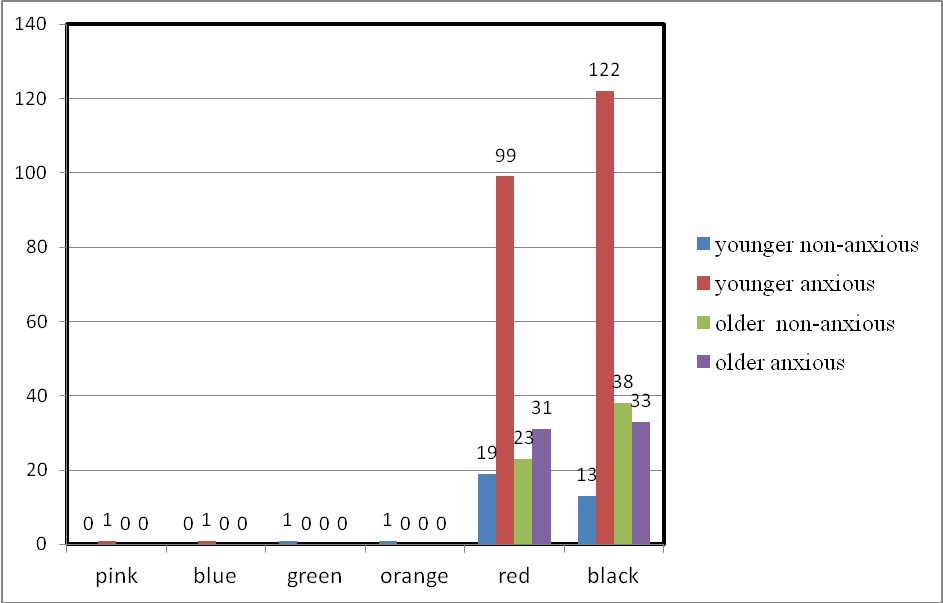
Z-test was performed to assess the difference between younger and older children in preferring different colors. Statistically significant difference was observed between younger and older children in preferring blue (p=0.004) but not other colors when they were in positive emotion. When the children were in negative emotion the preference of red (p=0.59) and black (p=0.81) between younger and older children was statistically not significant [Table/Fig-9,10].
Colour preference to positive emotion based on age group.
| Colour | Younger children (6-9 yrs) | Older children (10-12 yrs) | Total | Z value | p-value |
|---|
| Blue | 68 (26.5%) | 51 (40.8%) | 119 (100%) | 2.8 | 0.004* |
| Pink | 77 (29.9%) | 35 (28%) | 112 (100%) | 0.39 | 0.69 |
| Yellow | 46 (17.9%) | 19 (15.2%) | 65 (100%) | 0.6 | 0.51 |
| Green | 39 (15.2%) | 11 (8.8%) | 50 (100%) | 1.7 | 0.08 |
| Orange | 21 (8.2%) | 8 (6.4%) | 29 (100%) | 0.61 | 0.54 |
| Red | 4 (1.6%) | 1 (0.8%) | 5 (100%) | 0.61 | 0.54 |
| White | 2 (0.9) | 0 (0%) | 2 (100%) | - | - |
* p ≤ 0.05 was considered statistically significant
Z test was used
Colour preference to negative emotion based on age.
| Colour | Younger children (6-9 yrs) | Older children (10-12 yrs) | Total | Z value | pvalue |
|---|
| Red | 118 (45.9%) | 61 (48.8%) | 179 (100%) | 0.53 | 0.59 |
| Black | 135 (52.5%) | 64 (51.2%) | 199 (100%) | 0.24 | 0.81 |
| Others | 4 (1.6%) | 0 (0.0%) | 4 (100%) | | |
* p ≤ 0.05 was considered statistically significant
Z test was used
Discussion
There are several similar studies in the literature but [3,8,9] none of them have evaluated the difference in colour preferences in relation to gender. This study was conducted to evaluate the color preference to emotions (happiness and sadness) in relation to children’s age, gender and anxiety level. A total of 382 children aged 6-12 years were randomly selected from the schools of Puducherry.
Although there are many methods available to assess the anxiety level in children, we have used Modified Dental Anxiety Scale to assess anxiety in our study. This scale has minimal instrumental effects and sound psychometric properties, which makes it an important clinical tool in the assessment of dental anxiety. Additionally, it has a question regarding local anaesthetic injection anxiety, which could be of great importance in pediatric patients [10].
Dental environment plays a significant role in a child’s behavior and cooperation towards treatment [11]. Children’s dental anxiety has been of great worry for many years and it is still a hurdle to dental care [3]. In fact, anxious children might miss or avoid the dental procedure as they misjudge it to be extremely painful which could lead to ill effects on their oral health [1]. The outlook of dental set-up and the way a child observes it plays an important role in causing anxiety [3]. Pediatric dentists should bring in a more child-friendly ambience in their clinic to cope-up with the changing expectations of children.
Colour is an integral part of our day today lives and its presence is seen in everything that we perceive. The fact that colours play a vital role in our feelings and expressions has been widely accepted [12]. The bond between colour and emotion is closely coupled to colour preferences. In particular, colour preferences are linked with whether a colour imparts positive or negative feelings [13].
Colour has significant impact in children’s lives as evidenced in their clothes, toys, sports, home accessories lunch boxes [8]. It plays an important role in a child’s physiological and psychological perception.
The use of colours in our practice help both the child and staff to feel more relaxed while in a dental set up. Incorporating colourful equipment also adds to this benefit. For several years, clinical psychologists have offered assumptions about the emotional significance of colour [13]. In this study it was decided to include eight easily identifiable colours – pink, blue, green, yellow, orange, white, red and black and two emoticons representing happiness and sadness. Terwogt & Hoeksma, carried out a study with similar intent in which basic emotions like anger, happiness, sadness, fear, surprise and disgust were represented by red, blue, yellow, green, black and white colours respectively [14]. They found that the relationship between colour and emotion preferences varies as age advances. Correlation between colour and emotions were better for younger children compared to older ones [3,14,15]. This is consistent with the theory that as the individual gets older his/her preferences change based on their experiences [7]. Thus we included two age groups in our study i.e., 6-9 years and 10-12 years. Younger children (6-9 yrs) preferred pink and older children (10-12 years) preferred blue significantly more than the other colours for positive emotion.
Clinicians have experientially described that the emotional status of a child affects their choice of colour [8]. For example, blue is linked with calmness and security, orange is professed as stressful and disgusting, yellow as cheery, purple as noble [16]. The colour red has both positive and negative impact such as active, strong, and adoring, but on the other hand hostile, raging and forceful. Green colour has a timid and comforting effect. It too represents both positive and negative feelings [16]. In our study when the children were in positive emotion, a majority of them preferred blue and pink. Alternatively, when the children were in negative emotion, red and black were their choice. Obviously colour preference varies significantly with status of emotion.
Boyatzis and Varghese, Hemphill have showed that light colours are linked to positive emotions and dark colours with negative emotions in their studies on colour – emotion association [8,15]. In our study colours like pink, blue yellow were attributed to positive emotion (happiness) whereas red and black, to negative emotion (sadness). But, Saito [16] found that in Japanese subjects black colour is linked to both negative and positive responses. However, in the present study, children chose black colour to represent negative emotion only.
As anxiety level can vary on an individual basis, in our study children were divided into anxious and non- anxious groups based on modified dental anxiety scale. Anxious children preferred pink as their favourite colour to shade happy face whereas non-anxious children preferred blue, which is consistent with the study by Umamaheshwari N et al., [3].
A colour wheel demonstrating the psychological impact of different colors was developed by Goethe in 1840 [17]. He observed that blue imparts a sense of coolness and yellow produces a warming feel. Colour blue was found to have effects like relaxation of muscles, lowering blood pressure and calming restless children in various studies [3,7,17]. Pink also had similar calming effects on subjects and was also utilised in certain state prisons to control violent inmates. Our observations were similar to this which also showed children preferring pink and blue to demonstrate happy feelings [7].
Pope DJ et al., [13] found that there is a significant gender difference in specific color preferences. In the present study there was statistically significant association between gender and color preference. Girls preferred pink while most of the boys preferred blue to represent positive emotion. This may be due to cultural impact as most of the parents bring up girl babies in a pink environment and boys in a blue background in his/her toys, clothes and room accessories [8,13].
The child’s perception of the dental environment is a significant factor causing anxiety. A pleasant and colourful environment relieves the anxiety of children and also projects the office ambience [7].
Limitation of this study was that only two emotions (happiness and sadness) were evaluated. More emotions need to be evaluated in a larger population for better correlation.
The clinical implication of this study is that, by assessing anxiety level and identifying child friendly colours we can incorporate such radiant colours to the clinical set-up which will help to reduce children’s anxiety and thereby making the dental procedure less time consuming and stress free.
Conclusion
The relation of colour and its effects on emotions is based on the perception of colour and the environment and emotional relationships individuals have experienced. Colour and ambience of the dental clinic has significant impact on a child’s behavior and response to treatment. Hence, we concluded that there is a significant association present between color preference and emotions in relation to children’s age, gender and anxiety level. So by adding attractive colours like blue and pink to the dental environment and by incorporating colourful equipments could enhance a positive attitude and make the child be at ease. While black and red might impart a negative outlook in their mind.
* p ≤ 0.05 was considered statistically significant
Chi-square goodness of fit test was used
Z – test was used
* p ≤ 0.05 was considered statistically significant
Z test was used
* p ≤ 0.05 was considered statistically significant
Z test was used